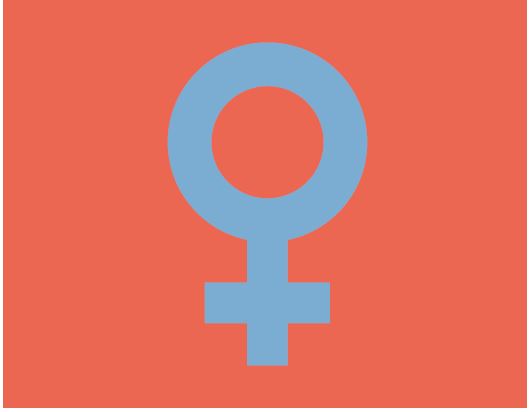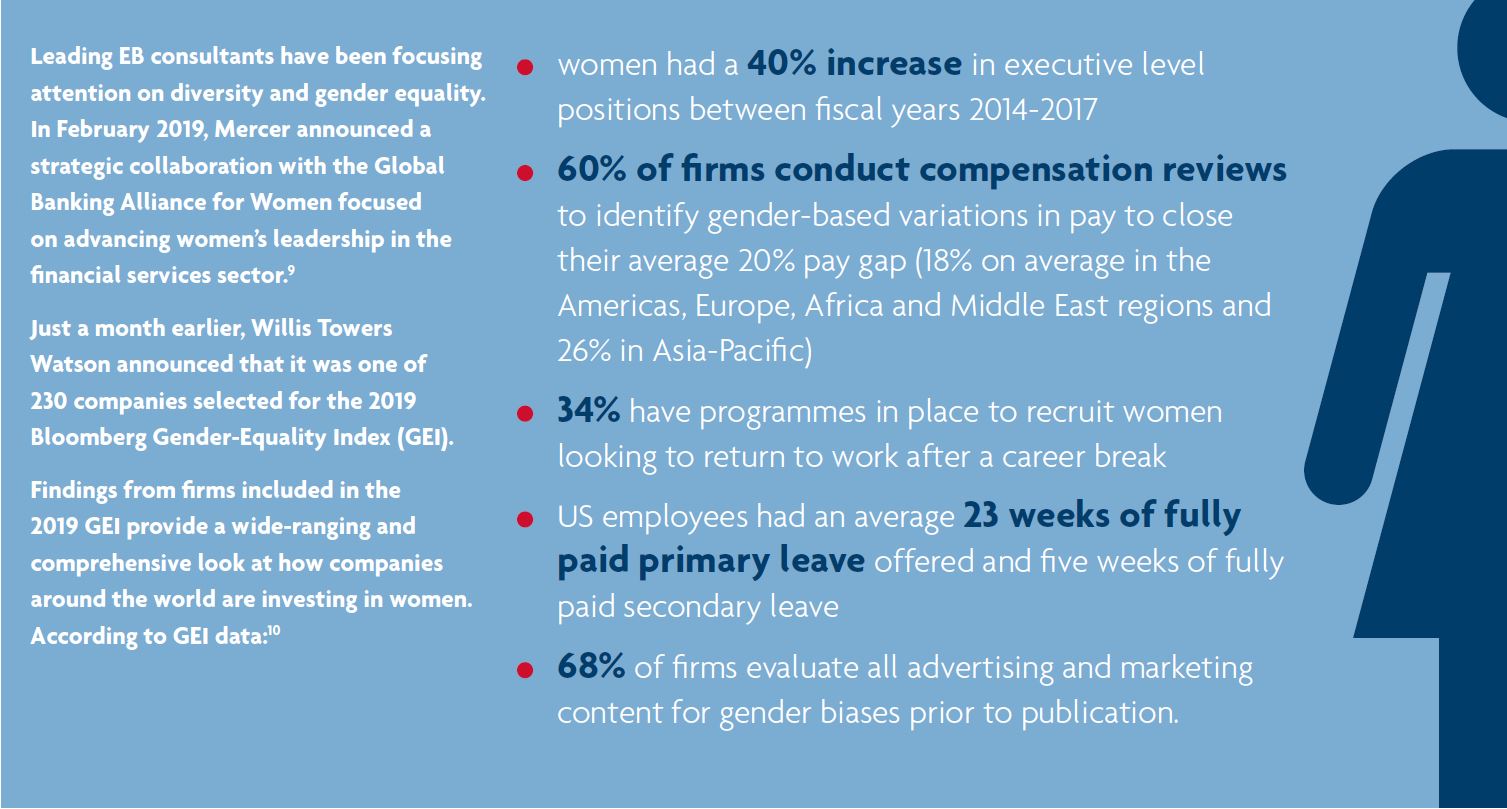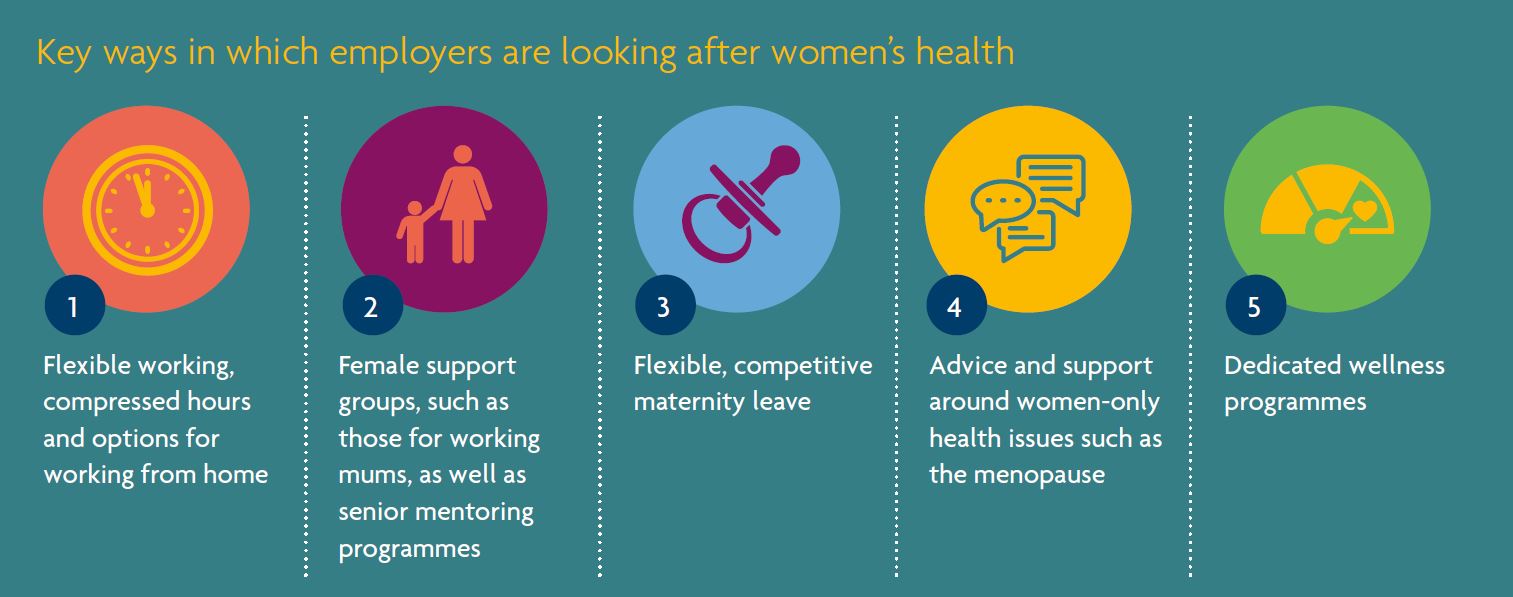NEWS
Wednesday 6 March 2019
With attitudes towards gender equality and diversity continuing to improve the world over, ensuring that women are in a position to thrive and reach their full potential is an ever-more important topic for multinationals. Of course, we mustn’t forget that gender equality issues affect everyone and not all of the ones we’ll talk about are only female-specific. However, with International Women’s Day almost upon us, this Viewpoint focuses purely on women in the workplace.
It is vital that employers understand that many workplaces, equipment and even traditional benefits have been primarily designed for male employees and that this needs addressing.The press in the UK has recently covered the story of a police officer who needed breast reduction surgery in order that her required safety body armour would fit. Even your office’s air conditioning is set up according to a man’s metabolic rate which is why your female staff can often be seen wearing an extra thick layer of clothes.1
Many multinationals look to differentiate themselves and appropriately cater for the needs of their female staff throug the employee benefits (EB) packages they offer. Naturally, women face a number of different health issues compared to their male colleagues from increased risk of certain chronic conditions to working through the menopause. It is also still more likely that a woman is the primary carer for their children and increasingly for elderly relatives, meaning they are faced with the challenge of trying to progress their career while caring for their dependents.
Employers are increasingly considering how they can tailor their corporate policies and EB packages to better cater for the needs of their female staff.
“…a police officer needed breastreduction surgery in order that her required safety body armour would fit.”
Building benefits programmes for female employees
To do this, many organisations are beginning to develop specific EB programmes tailored towards their female employees. Given the size of its economy and the fact that many of its companies are global leaders in their
sector with women in senior management positions, it is not surprising to find many firms in the United States (US) are leading the way in this area.
While many businesses are offering flexible working, paid maternity leave and leadership and support programmes as standard, some US firms have taken their benefits programmes a step further. Many multinationals, particularly in the technology, consulting, financial services and healthcare sectors, are offering new and innovative ways of supporting their female employees.
“some tech companies have even begun offering egg freezing as an option for their female employees wishing to delay having a family later in life”
For instance, mothers working at Google in the US can have errands done for them such as booking tickets and picking up groceries by a Google-sponsored concierge service, along with flexible hours and five months of 100%-paid maternity leave.2 This length of paid leave is a real differentiator given there is no federal paid maternity leave and 25% of women are forced to return to work within two weeks of giving birth in order to support their families.3
At American Express, new parents are given access to a 24-hour lactation consultant and mothers travelling for business can ship their breast milk home for free. 4
With more women having children in their 30s rather than in their 20s for the first time in history, some tech companies have even begun offering egg freezing as an option for their female employees wishing to delay having a family until later in life. 5 US health products company Abbott offers a range of ‘work life programmes’ such as assistance with adoption, reimbursement for fertility treatments and a Mothers at Work programme. Amazon offers two programmes for new parents including Ramp Back, which gives new mothers more control over easing back into potentially hectic work schedules.2
Flexibility is the key when returning from maternity leave
According to a report from the non-profit Henry J Kaiser Family Foundation (KFF), women now comprise nearly half of all workers in the US, and 70% of mothers with children under the age of 18 are now in the workforce.6
But, as the KFF found, women more often than not need more flexibility from employers than they currently receive. 40% of working mothers said they have had to take time off work to look after their sick children. This is four times the number of male employees who said they had done the same. And among the working mothers who had to miss work when their children were sick, 56% said they were not paid for the time off.
“40% of working mothers said they have had to take time off work to look after their sick children.”
Considering and implementing real flexibility for working mothers can be key for employers looking to attract and retain experienced female employees in their businesses.
Changing attitudes to women in the workplace
As well as flexibility, employers are beginning to consider the impact that women’s specific health conditions can have, and how they can best cater for them in the workplace. In a powerful example of the need for firms to
be much more conscious towards how they treat female workers, one UK lawyer warned in a recent article that an employer’s failure to offer any effective support for female employees going through the menopause is
currently costing the UK economy millions each year.
“Many academic studies have concluded that women have a higher rate of chronic health problems than men”
“A lack of understanding around the process means that the menopause is now having a serious impact on women’s economic participation. There are now more women over 50 in British workplaces than ever, with one in three workers expected to sit in this category by 2020.”
For many businesses, taking this sort of formalised approach to their female employees, health and wellbeing is likely to equire a significant shift in attitude. But it shows that increased awareness around femaleonly health issues is likely to become more common going forwards.
Many academic studies have concluded that women have a higher rate of chronic health problems than men. One major study, based on data in Spain, found women’s higher rate of chronic problems can be most strongly attributed to five chronic disorders: arthritis, mental disorders, neck pain, headaches and back pain.8 With more women in workplace than ever before, how multinationals reflect this in their EB programmes can be key to keeping their female employees healthy, productive and in work.

Gender diversity: a significant gain for businesses
Having appropriate benefits and coverages for women is important for businesses, and not just because it’s “the right thing to do”. Improving levels of gender equality in the workplace could have huge gains for businesses.
In a speech in November last year, the UK Minister for Women, Victoria Atkins, said “Companies in the top quartile for gender diversity are 15% more likely to have financial returns above their industry averages.”
Similarly, a McKinsey report estimated that bridging gender gaps in work in the UK could add £150 billion to the UK economy by 2025.12 An earlier report from McKinsey concluded that advancing women’s equality could add
US$12 trillion to global growth over the next seven years.13
By catering for women specifically with policies and benefits, businesses can look to tap into this huge potential.
“Companies in the top quartile for gender diversity are 15% more likely to have financial returns above their industry averages.”11
Summary
How employers treat their female workers and how EB programmes reflect this is expected to accelerate in importance over the next decade. Many firms have developed benefits packages to differentiate themselves in the marketplace and are actively developing and promoting specific solutions for working mothers and those with young families. However, there’s still much work to be done before this becomes common practice among employers.
Businesses have the opportunity to take a real lead and create benefits packages that truly help care for the needs of their female workforce. The net gains will be evident.

1 https://www.theguardian.com/lifeandstyle/2019/feb/23/truth-world-built-for-men-car-crashes Sourced Feb 2019
2 https://www.careeraddict.com/top-11-companies-with-best-employee-benefits-for-women Sourced Feb 2019
3https://www.forbes.com/sites/marybethferrante/2019/01/10/in-the-fight-for-paid-parental-leave-6-months-should-be-the-minimum/#dbe364d20735 sourced Feb 2019
4 https://www.glassdoor.com/blog/top-20-employee-benefits-perks-for-2017/ Sourced Feb 2019
5https://www.businessinsider.com/egg-freezing-at-facebook-apple-google-hot-new-perk-2017-9?r=US&IR=T Sourced Feb 2019
6https://www.kff.org/womens-health-policy/issue-brief/women-work-and-family-health-key-findings-from-the-2017-kaiser-womens-health-survey/ Sourced Feb 2019
7https://www.hrmagazine.co.uk/article-details/supporting-employees-through-the-menopause Sourced Feb 2019
8https://www.scientificamerican.com/article/why-women-report-being-in/ sourced Feb 2019
9https://www.uk.mercer.com/newsroom/mercer-and-gba-announce-strategic-collaboration-to-advance-womens-participation-in-financial-services-leadership.html Sourced Feb 2019
10https://www.willistowerswatson.com/en/press/2019/01/willis-towers-watson-selected-for-2019-bloomberg-gender-equality-index Sourced Feb 2019
11https://www.gov.uk/government/news/penny-mordaunts-new-mission-for-government-equalities-office Sourced Feb 2019
12https://www.ft.com/content/3d8cb9c2-01ff-11e9-99df-6183d3002ee1 Sourced Feb 2019
13https://www.mckinsey.com/featured-insights/employment-and-growth/how-advancing-womens-equality-can add-12-trillion-to-global-growth Sourced Feb 2019